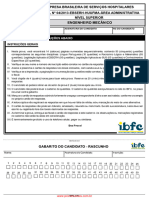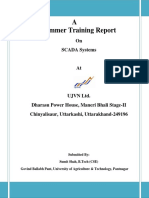Tutorial 7
Uploaded by
Muhammad SyafiqTutorial 7
Uploaded by
Muhammad SyafiqKarmila Kamil
Numerical Methods COEB 223
Semester 1 2013/2014
Tutorial 7
INTEGRATION
1. Evaluate dk k k ) 2 9 2 (
18
0
2
using the multiple Simpsons 1/3 rule with n = 6.
Answer: I=2466 (15 marks)
2. Evaluate the same integral in Question 2 using the three-point Gauss Legendre
method.
Answer: I2466 (15 marks)
3. Evaluate dx x
5
3
3 4 using a suitable combination of the Simpsons 1/3 rule and the
Simpsons 3/8 rule, with n = 5.
Answer: I=8
4. Miss Mimo is a fashion designer and knows very little about integration. She would
like to calculate the area under two curves (see Figure 1 below) from X = 0 to X = 6.
Given:
Curve 1 lies in the region of X = 0 to X = 3, where 1 5 2 ) (
2
X X X F
Curve 2 lies in the region of X = 3 to X = 6, where 9 2 3 ) (
2
X X X F
Use the 3-points Gauss Quadrature method and to help her calculate the total area
under the curves.
Answer: I=286.5 (20 marks)
Figure 1
0
20
40
60
80
100
120
140
0 1 2 3 4 5 6 7
F
(
X
)
X
Curve 1
Curve 2
Karmila Kamil
Numerical Methods COEB 223
Semester 1 2013/2014
5. In an experiment studying the motion of a supersonic missile, the velocity of the
missile, V is found to vary with the time, t according to the following equation:
t t t t V
2 3
3 2 ) (
It is well known that the distance covered by the missile can be found using
integration of the equation above.
Using a constant interval size of 2, use a combination of Simpsons 3/8 rule and
multiple Simpsons 1/3 rule with n = 4 to calculate the distance travelled by the
missile from t = 1 to t = 15.
Answer: I=28724.0454 [15 marks]
Semester 1 2010/2011, Answer :
6.
You might also like
- 177343-ATK-120200-SPC5AT-DRG-EOH-333000 Checking CommentsNo ratings yet177343-ATK-120200-SPC5AT-DRG-EOH-333000 Checking Comments1 page
- Extracto Destinos-Elementos-para-la-gestión-de-destinos-turisticosNo ratings yetExtracto Destinos-Elementos-para-la-gestión-de-destinos-turisticos76 pages
- Finale 2005 - (TRES DIAS - 001 Trumpet in BBNo ratings yetFinale 2005 - (TRES DIAS - 001 Trumpet in BB4 pages
- Finale 2007 - (PUERTO CABELLO - SAX TENORNo ratings yetFinale 2007 - (PUERTO CABELLO - SAX TENOR1 page
- A Predictive Model for Life Assessment of Automotive Exhaust Mufflers Subject to Internal Corrosion Failure Due to Exhaust Gases CondensationNo ratings yetA Predictive Model for Life Assessment of Automotive Exhaust Mufflers Subject to Internal Corrosion Failure Due to Exhaust Gases Condensation22 pages
- En Busca Del Imaginario Politico de La jNo ratings yetEn Busca Del Imaginario Politico de La j14 pages
- 0002 CHAPTER 21 GENERAL ANESTHETICS Goodman and Gilman The Pharmacological 13th - 4No ratings yet0002 CHAPTER 21 GENERAL ANESTHETICS Goodman and Gilman The Pharmacological 13th - 418 pages
- Business Startup Guides-Preparing Yourself Ver 2100% (1)Business Startup Guides-Preparing Yourself Ver 24 pages
- Averbach, Márgara - El brillo del petróleoNo ratings yetAverbach, Márgara - El brillo del petróleo8 pages
- Flow Design Formulas For Calculation - Exported From (HTM - 02 - 01 - Part - A)67% (3)Flow Design Formulas For Calculation - Exported From (HTM - 02 - 01 - Part - A)8 pages
- Reference Style - KU - Economics - Discipline - 2015 - 11 - 10-2No ratings yetReference Style - KU - Economics - Discipline - 2015 - 11 - 10-27 pages
- Research Publication and PopularizationNo ratings yetResearch Publication and Popularization55 pages
- ASLR On The Line - Practical Cache Attacks On The MMUNo ratings yetASLR On The Line - Practical Cache Attacks On The MMU15 pages
- Reichard et al.(2024).Elevating aspiring diverse leaders through PsyCapNo ratings yetReichard et al.(2024).Elevating aspiring diverse leaders through PsyCap10 pages
- Collaboration Specialist Training v2 - Cisco Endpoints: About This LabNo ratings yetCollaboration Specialist Training v2 - Cisco Endpoints: About This Lab48 pages
- Evidence For Slavic Lead Mining and Trade Early Rus - 2024 - Journal of ArchaeoNo ratings yetEvidence For Slavic Lead Mining and Trade Early Rus - 2024 - Journal of Archaeo10 pages
- Identifiability of Distributed Floodplain Roughness Values in Flood Extent EstimationNo ratings yetIdentifiability of Distributed Floodplain Roughness Values in Flood Extent Estimation19 pages
- Length Check Latex Template For Preparing An Article For Submission To Optica Publishing Group Journals Ao Jocn Josa A Josa B Ol OpticaNo ratings yetLength Check Latex Template For Preparing An Article For Submission To Optica Publishing Group Journals Ao Jocn Josa A Josa B Ol Optica4 pages

























































































